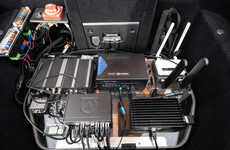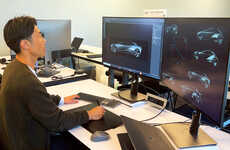
Toyota Research Institute & Stanford Engineering are Pioneers
References: youtube & prnewswire
Toyota Research Institute and Stanford Engineering have achieved a groundbreaking milestone by executing a complex maneuver in motorsports with AI — an autonomous tandem drift sequence. The research for autonomously drifting two cars in tandem, which is focused on improving driving safety, has been in development for nearly seven years. The tandem drift sequence simulates dynamic driving conditions, demonstrating the potential for advanced safety systems to help drivers maintain control in challenging situations, such as on snow or ice. Using advanced AI and a neural network tire model, the vehicles can learn from each experience, allowing them to navigate the track while maintaining close proximity to each other.
The experiments were conducted at Thunderhill Raceway Park using modified GR Supras, with Toyota Research Institute developing control mechanisms for the lead car and Stanford engineers focusing on the chase car's adaptive algorithms. The cars communicate in real-time via a dedicated WiFi network, continually planning and adjusting their movements using Nonlinear Model Predictive Control.
Image Credit: Toyota Research Institute and Stanford Engineering
The experiments were conducted at Thunderhill Raceway Park using modified GR Supras, with Toyota Research Institute developing control mechanisms for the lead car and Stanford engineers focusing on the chase car's adaptive algorithms. The cars communicate in real-time via a dedicated WiFi network, continually planning and adjusting their movements using Nonlinear Model Predictive Control.
Image Credit: Toyota Research Institute and Stanford Engineering
Trend Themes
1. Autonomous Tandem Drifting - The successful execution of complex tandem drifting maneuvers by AI showcases significant advancements in autonomous vehicle control and precision.
2. AI-enhanced Driving Safety - Utilizing AI to improve driving safety, particularly in challenging conditions such as snow or ice, highlights the transformative potential of smart safety systems.
3. Real-time Vehicle Communication - The implementation of dedicated WiFi networks for real-time communication between autonomous vehicles emphasizes the importance of connectivity in future mobility solutions.
Industry Implications
1. Automotive Safety Systems - Innovations in AI-driven drifting techniques could lead to safer cars that can better handle adverse driving conditions.
2. Autonomous Vehicle Development - Advances in tandem drifting algorithms mark a significant step forward in the development and refinement of autonomous driving technologies.
3. Wireless Communication Technology - The need for reliable, high-speed communication between vehicles underscores the growing demand for advanced wireless networking solutions in the automotive sector.
4.7
Score
Popularity
Activity
Freshness
























